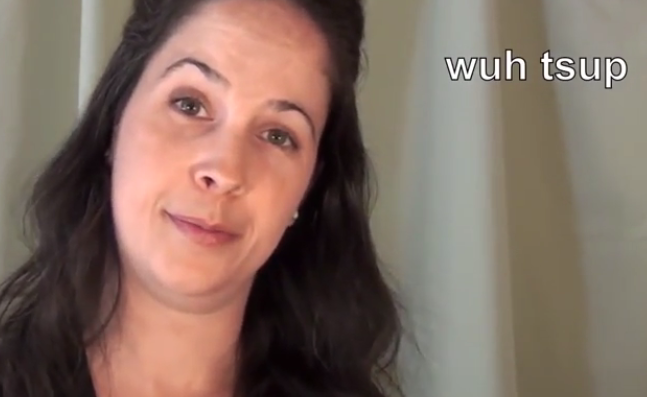The title of today's video is "wuh tsup". What's up?
今天的视频题目是“wuh tsup”。你好!
This video is about linking: the specific case where you take a word that begins with a vowel or a diphthong and you link it to the word before that ends in a consonant sound.
这个视频是关于连读的:在特定的情形下,如果一个单词以元音或复合元音开头,它前面的单词以辅音结尾,它们就要连读。
"Wuh tsup." I'm sure you are noticing that I'm putting the TS sound, the final consonant sounds of the first word, and I'm attaching it to the second word. "Tsup, tsup."
“Wuh tsup.”你一定注意到了我把第一个单词最后的辅音与第二个单词连到了一起,发了TS音。“Tsup, tsup.”
Let's look at this example, which has two cases where the consonant will link to the next word that begins with a vowel or diphthong.
我们来看一下这个例子,这里有两种结尾辅音与下一个单词开头的元音或复合元音连读的情形。
First, "hours". It's spelled with an H, but the first sound is the "ow" as in "now" diphthong.
首先是“hours”。它的第一个字母是H,但是第一个音是单词“now”里面的复合元音“ow”。

So, if we're going to take the consonant sound and put it at the beginning of that word, we're going to be saying "nowers":
因此,如果我们要在这个单词的开头连接一个辅音,我们就要说“nowers”:
"nowers, nowers." It's like we're making a new word. "Teh - nowers."
“nowers, nowers.”这就像造了一个新词一样。"Teh - nowers."
The next case, "a", is going to be the schwa sound. And we're actually going to take the Z sound from the word before: "zuh, zuh, zuh. "
下一个例子是“a”,它要变成弱读音。我们要在它前面连接一个Z音:"zuh, zuh, zuh. "
"Teh - nower - zuh - day. Ten hours a day."
"Teh - nower - zuh - day. Ten hours a day."
So taking the consonant from the end of one word and putting it on the next word that begins with a vowel or diphthong,
因此,将辅音结尾的单词和它后面以元音或复合元音开头的单词连读,
will make your speech sound much more connected, and much better linked.
这样会让你说话听起来更连接,连读得更好。
The T here in "what" comes between two vowel sounds, so we're going to pronounce it like a D.
这里“what”中的T出现在两个元音之间,因此我们要把它读成D音。
"That's wuh - dai - thought." "Dai" -- connecting it to the word "I". "Wuh - dai."
"That's wuh - dai - thought." "Dai"——把它和单词“I”连到一起。"Wuh - dai."
Now let's reconnect those: "what I, what I, what I", but still think of the D as beginning "dai, dai". "That's what I thought."
现在让我们再练一遍:"what I, what I, what I",不过还是要把D看成开头,"dai, dai". "That's what I thought."
This sentence has two words that begin with vowels, and the words before end in consonants, so we'll be linking.
这个句子里有两个元音开头的单词,它们前面的单词都以辅音结尾,因此我们要连读。
Again, the T is going to be pronounced as a D because it is between two vowel sounds."Wuh - dih - zit. Wuh - dih - zit. What is it, what is it?"
同样,这个T要读成D,因为它是在两个元音中间。"Wuh - dih - zit. Wuh - dih - zit. What is it, what is it?"
In this sentence, we're going to take the Z sound and put it at the beginning of the word anniversary: "zanniversary."
在这个句子里,我们要把Z音放在单词anniversary之前:"zanniversary."
"It's hih - zanniversary. It's his anniversary. "And here, "I - mon - the train. I - mon, I'm on, I'm on. I'm on the train."
"It's hih - zanniversary. It's his anniversary. "还有这里,"I - mon - the train. I - mon, I'm on, I'm on. I'm on the train."
Here, we'll take the S sound and put it at the beginning of the word "is"."Thih - siz - too much. Thih - siz, this is, this is. This is too much."
这里,我们要把S音放在单词“is”之前。"Thih - siz - too much. Thih - siz, this is, this is. This is too much."
Here, again remember, those T's between vowel sounds will be pronounced as D's. "Forgeh - dabou - dit. Forget about it."
这里,同样要记住,那些出现在元音之间的T要读成D。"Forgeh - dabou - dit. Forget about it."
That's it, and thanks so much for using Rachel's English.
这次的学习就到这里,非常感谢使用Rachel's English。











